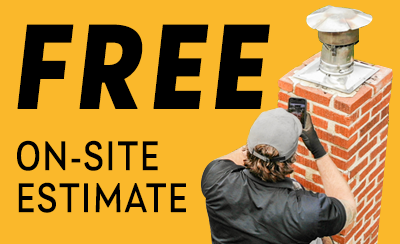The Dangers Of Creosote
Many homeowners in Niagara Falls, Irondequoit, and Western New York are unaware of the dangers of creosote buildup in the chimney until a severe event, such as smoke, an asphalt odor, or an alarming chimney fire, brings it to their attention. Creosote is a thick, black, tar-like substance that is a byproduct of wood combustion. Gas fireplaces also produce creosote but in smaller quantities. The major problem with creosote is that it will continue to build up in the flue until a qualified chimney sweep safely removes the flammable material. And it grows increasingly incendiary the longer it remains in the flue, increasing the risk of fire and exposure to toxic fumes.
 The Three Stages of Creosote
The Three Stages of Creosote
Creosote goes through three stages as it lingers inside the chimney system:
- Stage 1: is a flaky or brittle material that is easy to remove with a chimney brush.
- Stage 2: is a dark brown or black, oily, and flammable substance.
- Stage 3: is a thick, crusty substance resembling charcoal. As this stage, creosote is the most difficult to remove without professional assistance and is also the most dangerous.
Other Dangers of Creosote
Health Problems:
Creosote is a volatile organic compound that can enter the body through the lungs, stomach, intestines, and skin. Its continuous exposure can cause severe health problems, such as coughing, wheezing, and shortness of breath. In extreme cases, exposure to creosote fumes can even lead to death. Always wear goggles, gloves, and a mask before removing creosote.
Flue Obstruction:
If creosote buildup gets too thick, it can block the chimney flue. It prevents smoke and gases from efficiently escaping from the fireplace that could cause a backdraft sending harmful contaminants into your home.
Masonry Damage:
Creosote can also damage the brick or stone masonry. The heat from the fire can cause the creosote to expand and contract, which can crack the chimney lining and brickwork. This can lead to water leaks and other problems.
Signs of Creosote Buildup
If you are experiencing any of the following signs of creosote buildup, having your chimney and flue inspected by a CSIA-Certified Chimney Professional® is vital. A qualified chimney sweep will determine if you have creosote buildup and, if so, to remove it safely.
- Reduced draft: If your fireplace is not drawing as well as it should, it could be a sign of creosote buildup. Creosote can block the flue, making it difficult for smoke to escape.
- Black soot around the fireplace: soot around the fireplace or on the firebox walls is a dangerous sign of potential creosote accumulation. It can flake off and fall into the fireplace, leaving behind a shiny black residue.
- Dark smoke coming from the chimney: If you notice that the smoke from your chimney is dark and thick, it is yet another sign of creosote.
- Greasy, tar-like spots on the inside of the chimney: If you look inside the flue, you may see slick, tar-like spots. These spots are a sign of creosote buildup.
- Cracking or crumbling bricks: If the bricks are cracking or crumbling, it may be due to the dangers of creosote. Creosote, along with corrosive residue from combustion gases weaken the bricks, making them more likely to spall.
 Buffalo, NY Chimney Inspection & Creosote Removal
Buffalo, NY Chimney Inspection & Creosote Removal
If you suspect creosote in your chimney, we can remove it to protect your home and family.
From chimney inspection and creosote removal to fireplaces, heating stoves, and supplies, Felgemacher Fireplace Shop in Cheektowaga, NY, has everything your hearth desires for maintaining a safe, clean chimney.
Call (716) 907-4914 (Buffalo/Rochester) or contact us online to schedule an appointment today!



